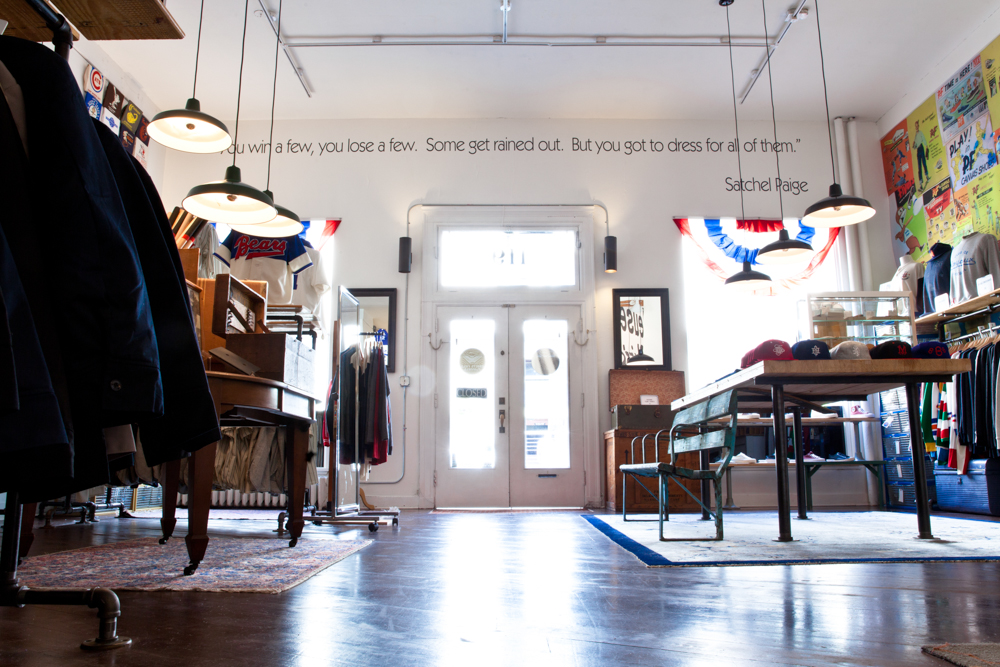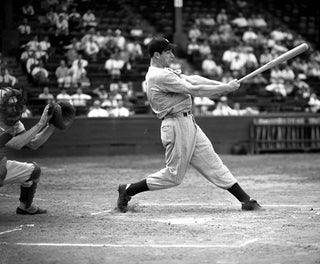The following article is taken from the upcoming Fall/Winter 2014 issue of The Hundreds Magazine:
There’s a difference between chasing trends and becoming open to the fact that audiences change over time. Treading those grounds to the best of its ability, Ebbets Field Flannels has managed to turn itself into the country’s premier destination for authentic sportswear reproductions, through a rigorous process of keeping sports history alive by any means necessary. What initially started as a simple solution to a void in the marketplace, for company president Jerry Cohen, has become an in-demand brand that produces both its own in-house collection of product, while simultaneously collaborating and manufacturing headwear and apparel with, and for, some of the most recognizable names in fashion and street wear.
I recently paid a visit to The Emerald City, the place Ebbets Field Flannels has called home for the past quarter-century, to catch up with Mr. Cohen and get a firsthand account of how the company came to be. Most importantly, he touches upon Ebbets’s insistent approach to only using the finest, authentic methods of production around and how it has managed to find a new lane for business over recent years, while still keeping its long-time fan base happy over time.
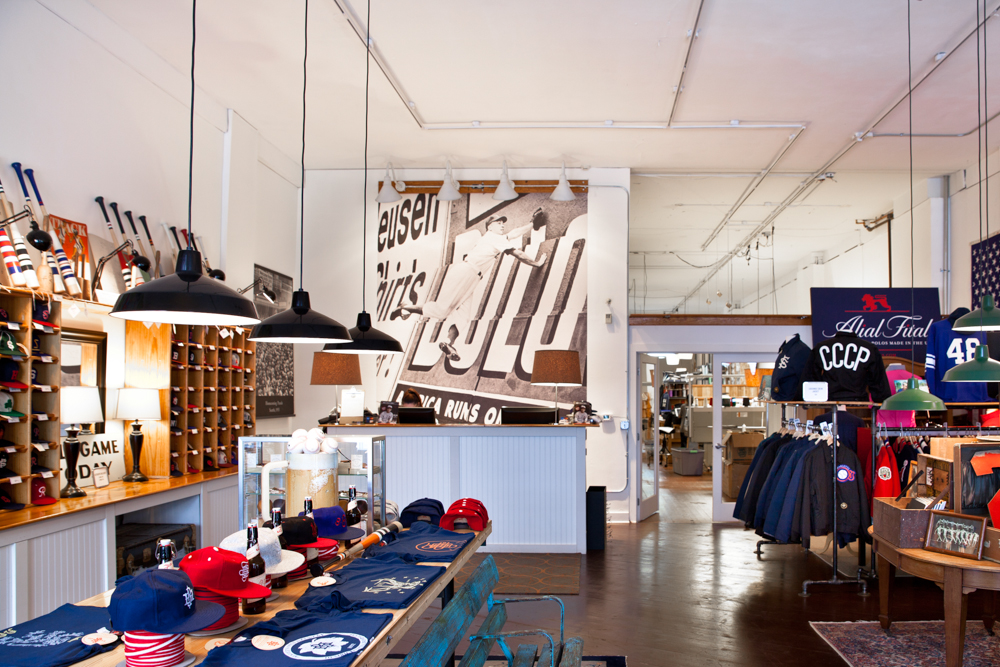
A look inside Ebbets Field Flannels on 119 S. Jackson St. in Seattle
How has your clientele changed in the past 20 years?
That’s a good question. It’s changed a lot because we started off with a group of people who I would say were really hardcore baseball history aficionados. And it was a good group and a loyal group, but it wasn’t a growing group. It was, in some sense, aging. And starting about five years ago, we brought a whole new group of people – younger people like yourself who really were more curious about the manufacturing and quality elements of it – that really brought us a new generation of customers. And so now we have kind of two: we have the traditional base, and then we have a much younger base who found out about us from the blogs from J. Crew or Inventory Magazine and that world. It’s given the company a whole new growth spurt. And it’s been fun because suddenly there’s new blood and we get to work with a lot of creative people. Collaborations like with The Hundreds and with some others have really been interesting and exciting because we can take what we do but also put somebody’s spin on it and that’s really great. I had to allow that to happen. We had to decide on the one hand, we’re purists, but you can’t be a cranky old guy just making your one baseball hat for a dwindling band of diehards. I never really wanted to be that. You have to be a living, breathing company. I think, to our credit, we have found a way to take the magic of what we do and the core values – not compromise on those, but broaden it so that it breathes and it’s more dynamic. I think that’s been, really, one thing I’m proud of accomplishing.
It doesn’t seem like you really alienated your original fan base.
T-shirts is really the one area... We used to sell lots and lots of T-shirts. If anything, we probably sell fewer now. The reason is in the sports world, the beefy T is considered the quality T-shirt and we changed to Made in U.S.A. only blanks, and we started to use a finer cotton, and that original base didn’t understand that. Every week I have to talk somebody down [because] they equate quality with weight of the shirt. I have to explain, “No, the shirts are actually more expensive.” And they think they’re cheaper and that’s very frustrating because I pay the invoice. [laughs]
So I think that’s the only place where we’ve maybe lost a few. The hat is a great example of where the confluence is perfect between the traditional customer and the new customer, because everyone settles on that from a price point of view, authenticity, fabric – that was a lot of our growth. Fortunately now, we’re diversifying and we’re selling a broader range of things to the market, where it was really headwear-based for a couple years.
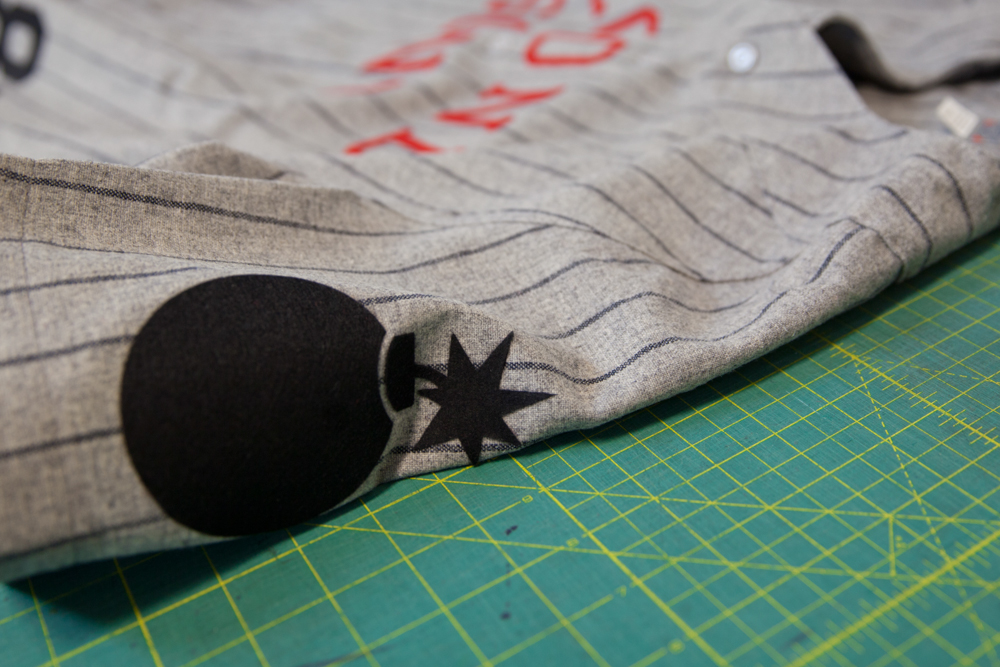
Production of a very special piece soon to be released
You’ve worked with J. Crew, you’ve worked within street wear, you’ve worked with guys in Japan. The project that I personally liked was the PF Flyers one. How was it working with those guys?
That was great! I grew up in the ‘60s and I remember the PF Flyers brand. I mean, that was it – you had PF Flyers and Keds. I don’t know why, but Converse, for us, wasn’t as big and then adidas came a little later. I was in junior high when people started wearing the three striped adidas, but earlier than that, it really was Keds and PF Flyers. I still remember the PF Flyers commercials, so when they reached out, I was thrilled because it was a perfect confluence of what we are excited about and they appreciated what we did. They’re great people and that’s always the best. I think we are really relationship-based. We are very fortunate that we end up working with people that we really like to work with.
Very rarely is it somebody who says, “Okay you need to do this.” There was one big company, I won’t name them, but it was really hard to work with them, you know? And then they didn’t pay! And then you’re like, “We realize you guys are good and everything, but it’s not fun for us if we do a lot of detail work and have to do audits and compliance. And then at the end of the day, have to chase you for money too.” But that’s the exception. All the brands we’ve worked with – Stussy, Supreme, Bathing Ape – most of them have been fun and I like the result; I’m not ashamed of any of the stuff that’s out there that has an Ebbets Field label.
Have you ever turned down a potential partnership?
One or two cases. We had Abercrombie and Fitch approach us. It turned out what they really wanted was to do what they do to everything already: a destroyed hat. I’m like, you know, Why do you wanna do that? You don’t need us to do that. That could’ve been a very bad move for us, I think. It would’ve been a huge order… let me tell you, their initial numbers were enormous. But we really debated it internally and it was not a good fit. I think they wanted the brand to put a veneer of street cred onto their brand. And they’re a very successful business obviously, so I respect that, but we just didn’t feel like it was a good partnership.
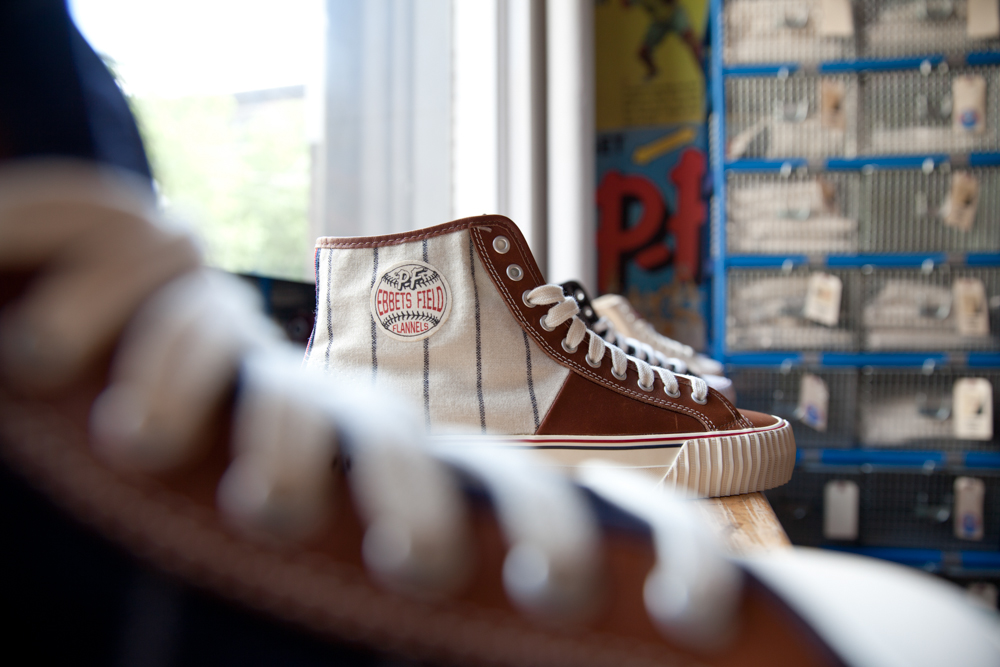
Ebbets Field Flannels x PF Flyers Center Hi
Who was the first of these contemporary brands to approach you?
J. Crew, because initially they had a collection called In Good Company, which was other brands they were bringing in like Timex and the Field Notes. [J. Crew’s buyer] was already a retail and catalogue customer of our hats and so that was the first. That was a small task actually, initially. Once that happened, our product was exposed to a totally different environment. I think around the same time right after, Inventory Magazine was a huge influence, because it placed us in the kind of “craft American brand” context.
[That] was four years ago, I think. So the phones started ringing a lot after that. And again, that’s when some of the streetwear brands came in and all that.
With some of these fabrics you use, are they just vintage rolls that you have to find? Or can someone actually reproduce some of this?
Depends. Technically there’s really no reason why it’s physically not possible to reproduce, but I’ll give you an example. They used to do a lot of rayon jackets and things like that. So I’ve been trying to get this [fabric] by Skinner who used to make it. They used to call it tackle twill and it’s totally different from what they call tackle twill today. It’s basically rayon yarn with a cotton backing on it. We finally got our supplier to come really close, but if you buy it untreated, it’s very shiny and it’s totally the wrong look for anything vintage.
[That’s] an example of where I have to go back and forth through the manufacturer. And the positive thing now, though we’re still very small, [is that] we’ve finally gotten big enough to where we have a little more buying power. Whereas even five years ago, I could walk into someone’s office with a jacket and they’d say, “Great, how many yards are you gonna order?” And I’d say, like, “500.” They’d laugh me out the door. That part is amazingly the same.
The other thing that’s happened is as time has progressed, the yarns and the content of things in the industry have changed, so it’s actually difficult to get a lot of things made the way they used to be. Rayon is a great example. It used to be kind of the go-to fabric for a long time, and then it became very difficult to get. That’s always a challenge with what we do.
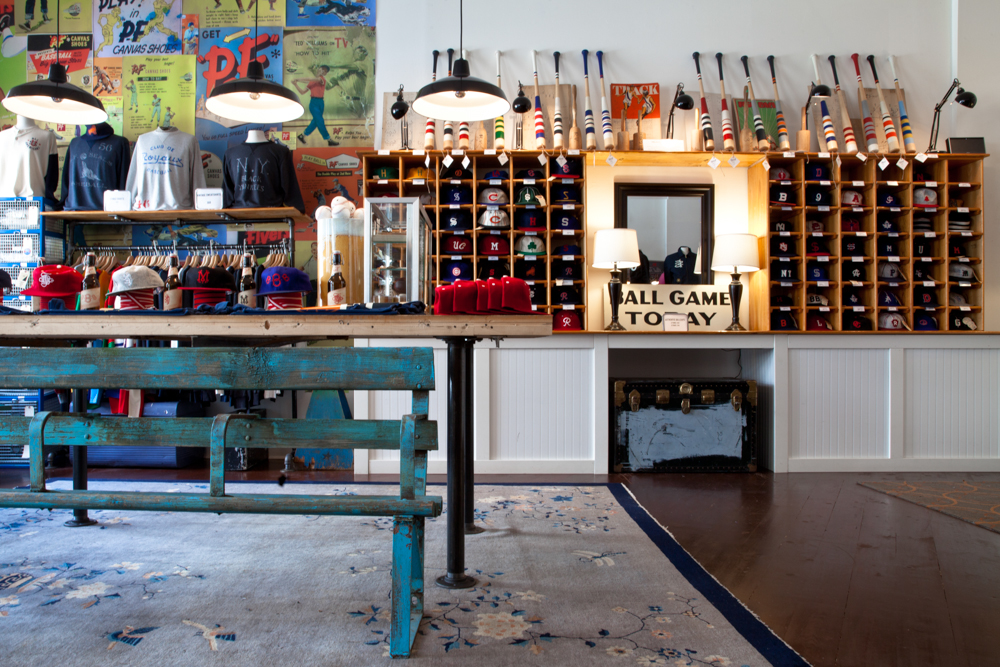
A selection of amazing product from Ebbets Field Flannels
What challenges did you face when you were starting your company 25 years ago?
Because of what we do, we face some of the exact same challenges now, and those are kind of old school manufacturing challenges. It’s like, “How can I get this fabric to make this thing I wanna make?” The only thing the Internet and digital technology has made easier is you can research things faster. I used to literally go to the library and look through directories of manufacturers. So you’d have a book and it’d have all the wool mills, you know? And then I’d photo copy that and I’d come home and I’d call them. And that was how I got my first baseball wool flannel because nobody made it. We still do that exact thing… I’m looking for one fabric, now that the Internet has not made a damn bit of a difference, where it just isn’t out there and the resources that could do it don’t seem to be out there. So the old fashioned legwork that we used to have to do hasn’t changed that much.
What’s changed is when someone sees something on the Internet. We publish our products, which are research-based, and then a competitor in many cases can instantly grab a logo and make a T-shirt. That has changed. And that is a much faster kind of reaction now than 20 years ago.
Where do you feel the U.S. has had an advantage in terms of production, if any?
In the case of athletic product, we started by actually working with the remaining original manufacturers. So you can’t get closer to the source than that. The problem was they started going out of business one by one after we started, because they hadn’t adjusted their business model. They were still living in the old world of trying to support a business model of supplying schools and that sort of thing. We came along and we were excited about stuff they did decades ago, but it was usually harder to get them as excited. I’d walk in and I’d say, “Hey, if you can make these jackets the way you did in the ‘40s…” ’cause I’d walk around their factories and they would still have the patterns and, in some cases, some of the fabrics. But they were stuck in a business model that had already started 20 years ago, to become overtaken by China.
The reason why we started out of the U.S. was not out of any kind of great altruistic sense, it was just that’s where the source was. And we were doing such low volumes anyway that China was not an option. We just stuck to our guns, you know? I tell people that we had to reinvent the wheel on our hat four times when manufacturers would call us up and say, “I’m not gonna make your hat anymore, we’re closing down,” or, “It’s too hard,” or, “We hired a consultant and the consultant said we should only do high volume.” We fought against that for years way before there was an appreciation for “Made in the U.S.” It was a very lonely fight, I have to say. And there was not the thing there is now [with] the trade shows and this market where there’s a resurgence of American craft manufacturing. That didn’t exist – that sensibility. All we had was inefficiency combined with high cost [laughs]. Which is a bad combination when our competitors were making off shore for a much higher profit margin.
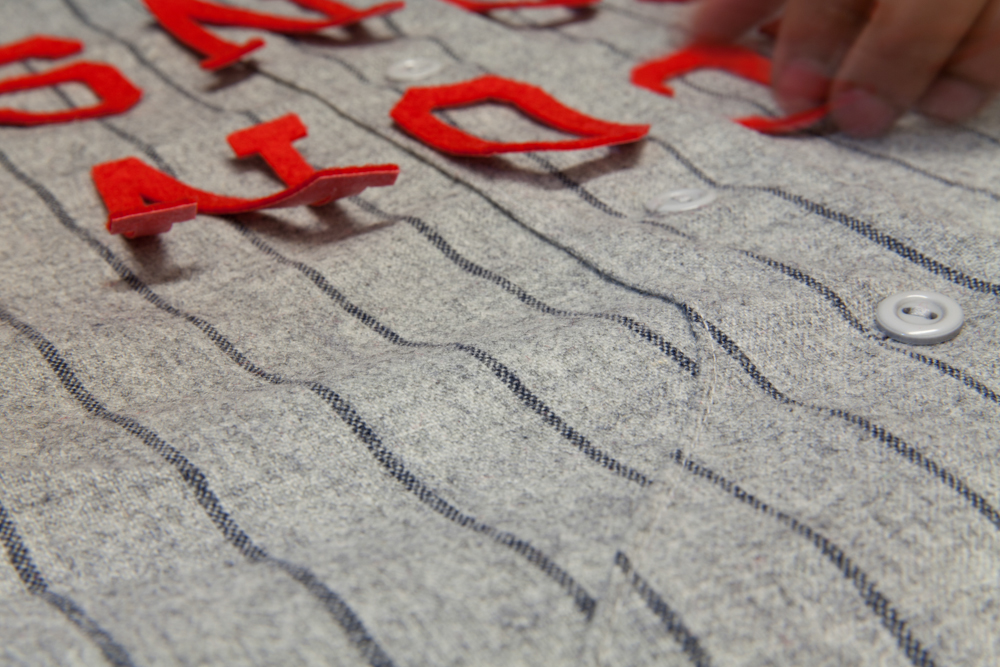
Ensuring alignment and placement is just right
Is there anything that you haven’t found that you’ve been looking for, for a long time?
There’s always things I’m looking for… There is a team – I just got fascinated by this – in the Quebec Provincial league, which went in and out of the organized baseball structure. Before Jackie Robinson, they were all white. But when they were independent, black teams competed in it. They would come – whole teams from Florida or wherever – and compete in Quebec. And so there’s a team and there’s one image that’s fantastic… the team’s called the Black Panthers and they had an enormous panther probably embroidered across the whole jersey, and then also a big panther head on the sleeve. There’s only one picture, and it’s a team picture, and none of it is good enough to get detail from. So that’s an example of something where I go, “Ah!” And I’ll spend a good amount of time looking to find a secondary source and then have to give up and move on.
There’s always things like that. There’s lots of history where there’s no photographic evidence...You’re like, “Gah, I would love to see what that is,” but it doesn’t exist.
A lot of what I’ve seen so far seems to be heavily influence by your youth. How cool was it growing up in Brooklyn, in the ’60s?
It was a great environment to grow up in as a kid because not only is it the city and the ‘60s – maybe everybody’s youth is their best time – but the music. Even AM radio in those days was just such a cross section of so many kinds of music and I got hit with the British Invasion – The Beatles – but also Motown and Stax and that was my soundtrack. The twin pillars of my childhood were baseball and music. You know, I wasn’t as good a player, and I realized that by the time I was 12 or 13 that it wasn’t gonna be my career, but fortunately I kind of found a way to be in that world and I think that’s really been fun for me.
You mentioned being a musician. What instrument did/do you play?
Guitar. I still play. I still record [and] collect vintage guitars, but that became a hobby I was able to indulge, when for ten years I really tried to do that. As you probably know, that’s a tough racket, especially now.
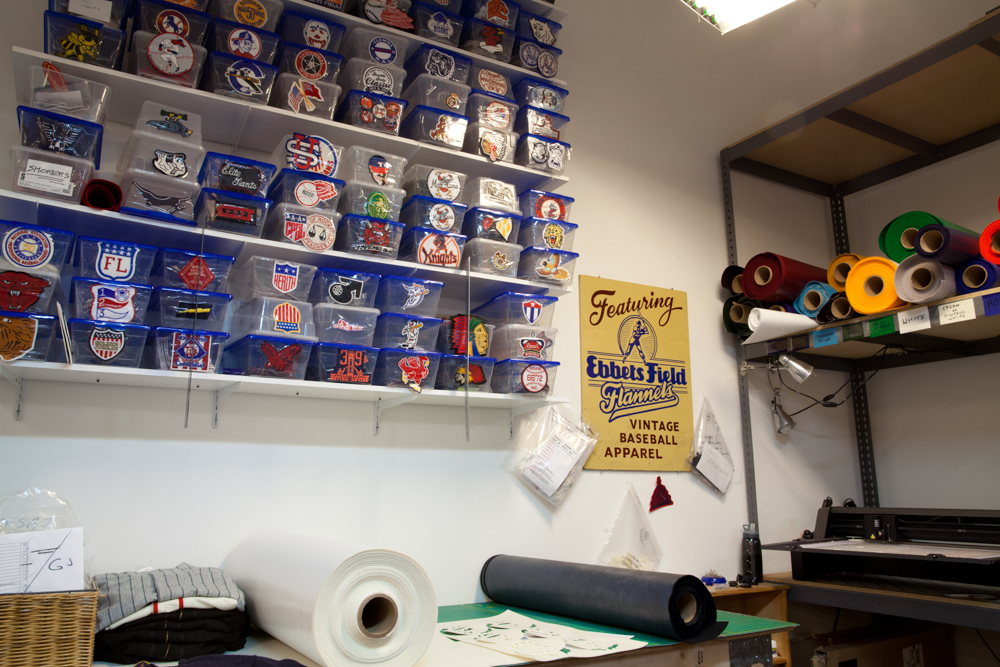
Ebbets takes great pride in masterfully reproducing original minor league baseball patches
I enjoy music from those eras (’50s & ’60s) because it has so much soul. Do you ever find inspiration from music when making garments?
Maybe it’s a stretch, but I do make the comparison between that and garments – athletic garments. You said “soul” and I think another way to say that is having an organic structure and an organic creation. I think it was a simpler time. It’s like, if you look at the design of athletic garments now [in professional sports], they’re designed by committees. Basically big design firms that are paid six figures. Frankly, as a professional, I look at some of the designs and I’m like, “You paid $300,000 for that logo? Really?” Whereas maybe in the ‘50s and ‘40s and ‘30s, somebody drew that. At some point, somebody just drew that Yankee NY and said this is cool. One color. You would never be able to get somebody to limit themselves to one color now on Adobe Illustrator in some design firm. “Well, let’s have five colors, let’s have all these trim levels…”
And I think music is the same, I mean, to use CCR (Creedence Clearwater Revival) as an example, when John Fogerty and his brother got together in the garage, they were clearly influenced by Southern music, Blues music, ‘50s Rock and Roll… and those are all organic soulful American musics. I think that I don’t want to be one of those old guys putting down Contemporary music because I hated that when I was a kid. We used to get so tired of people… of the older generation reminiscing about the Big Band era. So I don’t want to be one of those guys. But I will say that technology has changed music and access to technology is good and bad. You can do way more, and that’s great. How you do it is what makes it timeless or what makes it disposable. I think design is the same. I will say that in this world, there are a lot of people who can design but there’s very few who can draw.
